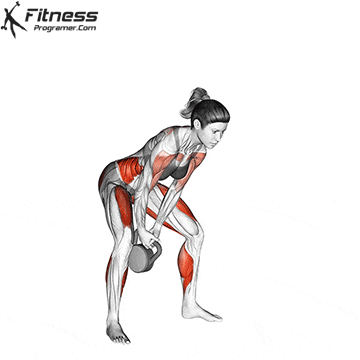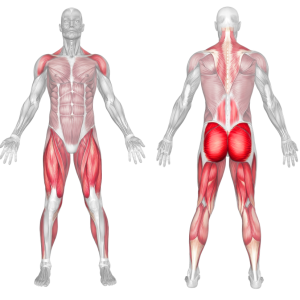Kettlebell Swing
The kettlebell swing is a dynamic and powerful exercise that involves swinging a kettlebell between the legs and up to shoulder height. This exercise, which is one of the basic movements in kettlebell training, is very effective for building strength, power and cardiovascular endurance.
How to do:

1- Stand with your feet shoulder width apart and grip the kettlebell with both hands, allowing it to hang loosely. Bend your knees and drop your buttocks backward slightly, leaning your torso forward from the hip and keeping your back straight.
2- Keeping your arms straight but relaxed, drive forward with your hips to stand tall, so that the kettlebell swings forward and up.
3- Allow the kettlebell to swing up as far as momentum carries it, and then back down toward the hips. As it approaches, drop your hips and lean your torso forwards, and keeping your back straight, to return to the start position.
Personal Trainer Tips:
- The kettlebell swing is a dynamic movement; it should flow continuously without pausing at the top or bottom.
- Stand with your feet 6–12 inches outside of shoulder width on either side, each foot pointed outward about 30 degrees.
- Keep your shoulders pulled back (retracted) and down to avoid rounding your back.
- The lowering movement (backswing) is a sitting-back-on-a-chair movement, not a squatting- down movement.
- Imagine pinching a quarter between your butt cheeks when you pop your hips forward.
- At the top of the swing, the kettlebell should be around shoulder height, and your body should form a straight line from head to heels.
Kettlebell Swing – Benefits
Full-body workout: Kettlebell swings engage multiple muscle groups simultaneously, including the hips, glutes, hamstrings, core, back, shoulders, and arms. This makes it an excellent full-body exercise that can help you save time while working on multiple areas at once.
Cardiovascular conditioning: Due to the dynamic nature of the movement, kettlebell swings elevate your heart rate and provide an intense cardiovascular workout. This can improve your endurance and overall cardiovascular health.
Strength and power: Kettlebell swings build strength and power, particularly in the posterior chain muscles (glutes, hamstrings, and lower back). Strengthening these muscles can help improve athletic performance and reduce the risk of injury.
Fat burning: As a high-intensity exercise, kettlebell swings can help you burn a significant amount of calories in a short period. This makes them an effective addition to a weight loss or fat loss program.
Improved posture and stability: The swinging motion requires proper form and engagement of the core muscles, which can lead to better posture and enhanced stability in the lower back and hips.
Increased flexibility: Kettlebell swings can improve hip mobility and flexibility, which is essential for various daily activities and athletic movements.
Joint-friendly: When performed correctly, kettlebell swings are relatively low-impact and place less stress on the joints compared to some other exercises.
Functional strength: The movements involved in kettlebell swings mimic real-life activities like lifting and swinging, making it a functional exercise that can improve your performance in daily tasks.
Versatility: Kettlebell swings can be combined with other exercises or incorporated into circuit training, making them a versatile choice for different workout routines.
Kettlebell Swing Muscles Worked
Target Core Muscles: ▪ Rectus abdominis ▪ Transverse abdominis ▪ Pelvic floor ▪ Hip flexors ▪ Erector spinae ▪ Multifidus ▪ Quadratus lumborum ▪ Gluteus minimus/medius ▪ Gluteus maximus

